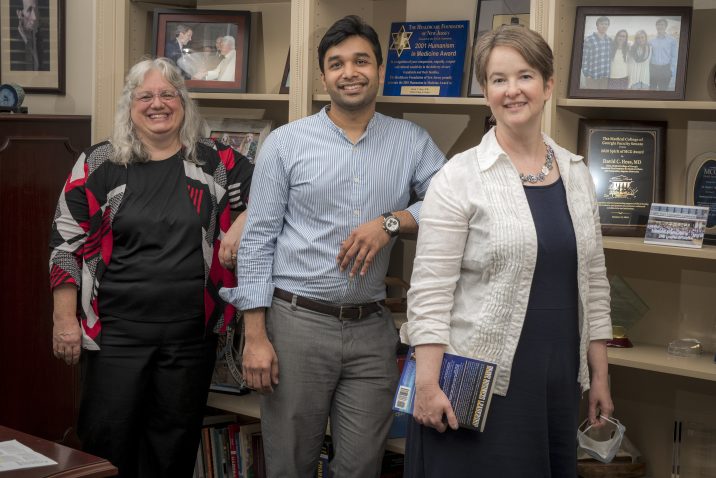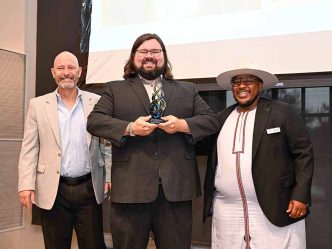It’s a pervasive bacterium found in soil and water that rarely causes disease, but a new national review of nocardia infection in people who have had a kidney transplant shows that when it occurs it most commonly causes pneumonia and brain abscess, and reminds their physicians to stay on the lookout for it, investigators say.
Nocardia is called an “opportunistic” agent because it doesn’t make most of us sick, but those with compromised immune responses, like patients who have had an organ transplant or cancer treatment, are more vulnerable, says Dr. Stephanie L. Baer, infectious disease physician at the Medical College of Georgia and chief of Infection Control and Epidemiology at the Charlie Norwood Veterans Affairs Medical Center in Augusta.
“Kidney transplant patients are at risk for all kinds of infections,” says Dr. Sandeep Padala, nephrologist at MCG and the Augusta University Health System.
While the dose and selection of immunosuppressive drugs are often adjusted, some combination of these drugs which help prevent the immune system from attacking a transplanted kidney, must be taken as long as the transplanted organ is present, and the longer those drugs are taken, the higher the infection risk, Padala says.
To look at how that increased vulnerability impacted these patients’ risk for nocardiosis, the investigators used the U.S. Renal Data System, a national database that collects, analyzes and distributes information on end-stage renal disease in the country, to look at 203,233 kidney transplant recipients from 2001-11.
For the study, published in the Journal of Investigative Medicine, they looked for patients who had been diagnosed with nocardiosis, failure of the kidney after the infection, along with demographics and risk factors.
They found 657 patients — less than 1% of the total, .32% exactly — had been diagnosed with a nocardia infection, a lower percentage than previous, smaller studies.
“Being older, having a brain abscess or being on specific immunosuppressants ended up translating to a higher risk of transplant rejection for these patients,” says corresponding author Baer.
Those infected tended to be age 65 and older, have a history of transplant rejection and/or failure and to have received their kidney from the more common deceased donor source rather than a living donor. In 2020, for example, there were 33,310 deceased donor transplants compared with 5,726 living donor transplants, according to the United Network for Organ Sharing.
Those infected also had been treated with a handful of common immunosuppressive drugs like cyclosporine and tacrolimus. Those treated with a drug called antithymocyte globulin, which reduces the action of drivers of the immune system called T cells, and who developed a brain abscess as a result of their nocardia infection were most likely to have their transplanted organs fail, the investigators report.
All told nearly 43% of all transplant patients experience failure of their transplanted organ, and that percentage jumped to 67% with nocardia infection.
One surprise was that those who had a history of transplant organ failure or rejection, a factor for many of these patients with nocardiosis, actually had decreased risk of their transplanted organ failing potentially because of heightened attention by patients and physicians alike because of their previous troubles, they write.
They say their analysis was the first large study in the country to look at risk factors for transplant failure in patients with a nocardia infection, and that the findings provide new information to enhance early recognition and targeted treatment of nocardiosis in these patients.
The take-home message: Don’t forget to screen for nocardia in these patients especially if they have a combination of pneumonia and brain abscess, Baer says.
“It they don’t respond to the routine antibiotics, then you have to start looking for unusual things,” Baer says.
They can look first in the blood for the bacterium, but when not present there in the face of classic symptoms, they may also need to do the much-more invasive bronchoalveolar lavage, essentially a lung rinsing often used to find the bug culprit in bacterial pneumonia, which enables sample collection for testing or an actual lung biopsy.
Blood cultures are routine in transplant patients but they don’t routinely look for nocardia, plus it can be present in the lungs and not show up in the blood, Padala notes. It’s only when more common bugs are not found that nocardia comes on the radar, he says.
“It’s a very difficult organism to both diagnose and treat because it’s a higher order bacteria; it’s more sophisticated than most bacteria,” Baer says. “It only likes to infect specific places in the body like the lungs and the brain and you have to use special stains to see it.”
Another major wrinkle is nocardia only responds to specific antibiotics, some of which are toxic to the kidneys, which is a primary reason they were looking at the impact of the bacterium in these patients, she says.
Baer notes that nocardia can be misdiagnosed as actinomyces, another bug found in the soil which is actually important to soil ecology and likes mucosal surfaces like the inside of the mouth. In fact, Baer notes the same diagnostic code is used for both infections, so they also looked at symptoms to try to zero in on nocardia, which may mean some nocardia cases were inadvertently left out of the study and reported numbers in reality might actually be higher in this cohort, Baer says.
When a patient with the infection is identified, infectious disease specialists like Baer work closely with nephrologists like Padala to find the best strategy for managing his/her care.
Nocardia hit Baer’s radar because of a patient who had what they suspected as the bacterium in his lungs but they could not detect it in his sputum. The infection eventually crossed over into the blood where it was readily diagnosed. They were able to clear up the bacterial infection but he ultimately died of other complications.
More study is needed to examine when infections occur and to identify preventive strategies to prevent the infection and its consequences, the investigators say.
People might get nocardia in their lungs by breathing in some dust or by digging in the dirt when a finger has a cut, according to the Centers for Disease Control and Prevention. The bacterium also can be present on medical equipment and get into a surgical wound, for example, following a procedure.
The brain is the most common site for a disseminated infection, which means it has spread in the body, and up to 44% of patients with infection in the brain or spinal cord die, the CDC says. Like a weakened immune system increases the risk of infection, it’s also known to increase the risk of death from the infection, the CDC says. Baer says less than 10 people died among the more than 600 they studied.
Dr. Maya Gibson, a 2021 MCG graduate now doing her pediatric residency at Children’s Mercy Hospital in Kansas City, Missouri, is the study’s first author.
Read the full study.
 Augusta University
Augusta University




